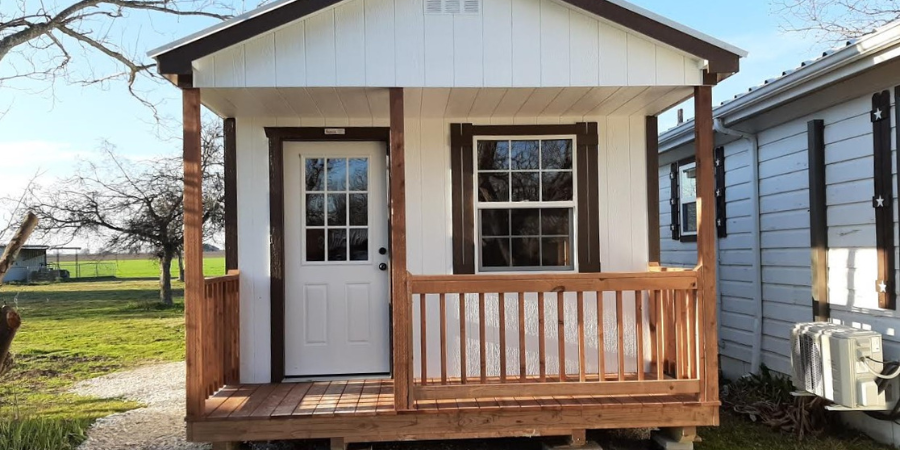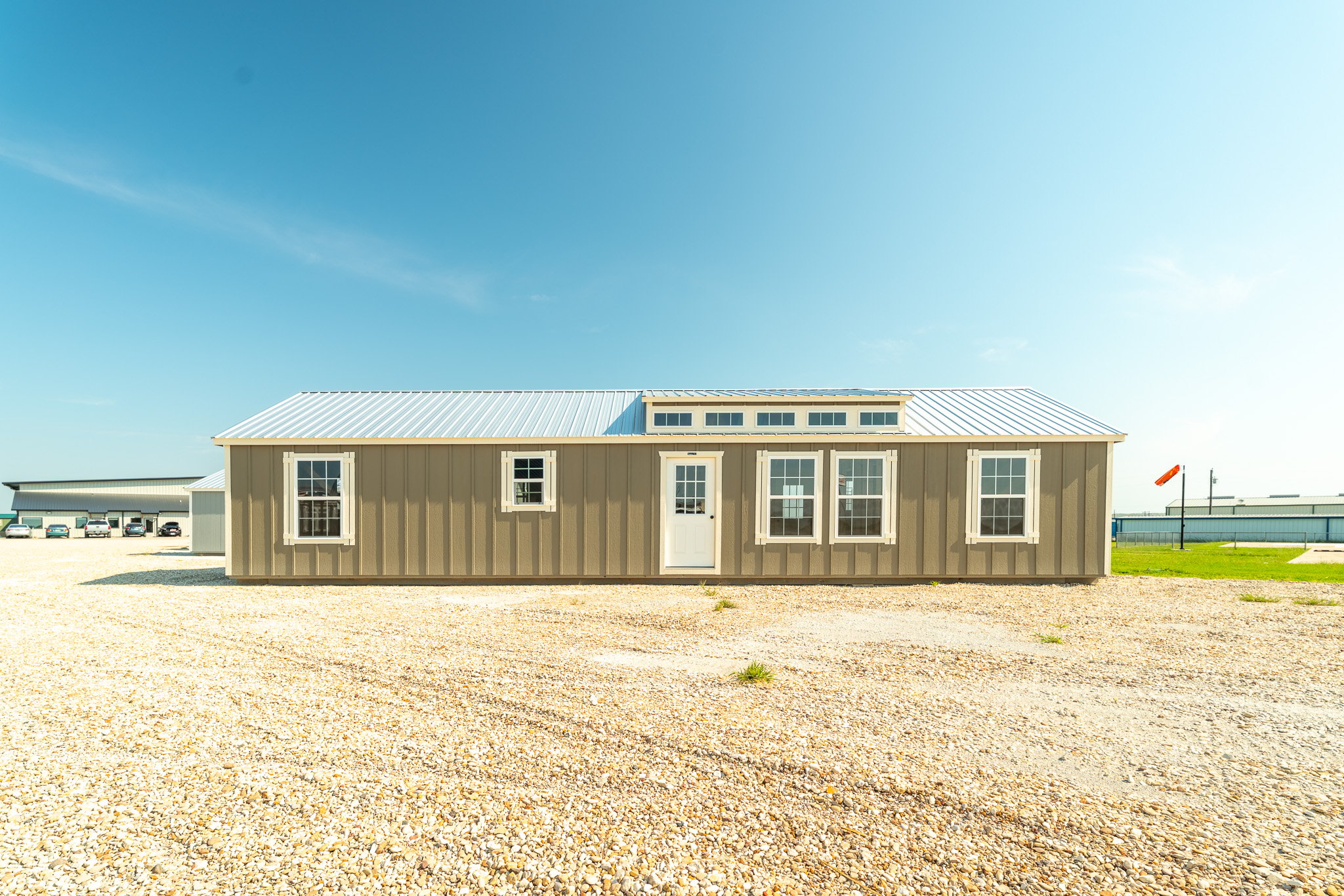Share this
Tiny House Shed vs. Traditional Cabin: Which Is Right for You?
by QSB on November 3, 2025 at 8:00 AM

Downsized living is catching on fast these days. Maybe you’ve seen those tiny home shows, or you’ve got a neighbor who turned a shed into a guest space.
Whether you’re looking for a smaller home for empty-nesters, hoping for less square footage to clean and manage, or wanting to add additional space for guests on your property, a small building can be the perfect way to achieve any one of these goals.
So the question becomes, “Do I go with a tiny shed house, or should I stick with a traditional cabin?” They’re both good options, but they fit very different situations. Let’s break it down the way we would if we were standing on your property, looking at where you want to build.
Tiny House Sheds: An Affordable Blank Canvas

When people say tiny house shed, nine times out of ten, they’re talking about a shed shell, which is a building with the roof, siding, and doors finished on the outside, but the interior left open for you to design and complete.
We see it all the time. Somebody picks up an unfinished shell, and they just get rolling with what matters most. One customer in Texas wanted theirs done fast before a storm came through, so the crew had it framed, painted, trimmed, and shingled in about four days. Others take their time. They’ll live with bare plywood walls for a bit, then add insulation and drywall later when the budget allows.
That’s the beauty of a tiny shed house: you can pace yourself and still end up with a space that’s 100% yours. It can start as a backyard office, then later turn into a guest suite, and eventually into a short-term rental. You control the timeline and the budget.
What to Expect with a Tiny House Shed
- Utilities take planning. You’ll often need to run electrical, plumbing, or HVAC separately since most shells don’t come with them. In many cases, you’ll want a professional to handle electrical and plumbing for safety and compliance.
- Comfort depends on insulation. Summers in Texas get hot, and winters can still dip low. Without spray foam or batting, you’ll feel the temperature swings.
- Permits may be simpler. Many counties treat sheds as accessory structures, making them easier to place on a property. Still, always check local rules, especially if you plan to rent it out.
Traditional Cabins: Built for Long-Term Comfort

A cabin feels different from the start. You’re not just putting up a simple shell. You’re talking about heavier framing, a foundation, and utilities built in. It’s a bigger upfront commitment, but the payoff is a space that’s ready to use right away.
We built one recently in Midlothian that shows what cabins are all about. The customer wanted 10-inch overhangs all the way around, a steep 10/12 roof pitch, and a side dormer to give the upstairs more headroom. We topped it off with custom Sherwin-Williams paint and even added a cupola (a small structure on top of the roof that adds style and ventilation). That’s the kind of detail cabins lend themselves to: solid, permanent, and built to last decades.
So if you picture family gatherings, hunting trips, or holidays in the woods, a cabin delivers that comfort and permanence from day one.
What to Expect with a Cabin
- Move-in ready. Utilities like plumbing, electrical, and HVAC are usually part of the build, so you can settle in right away.
- Higher property taxes. Because they’re considered permanent structures, cabins may increase your assessed property value more than a shed would.
- Permitting is stricter. Cabins are classified as dwellings, so they almost always require full building permits and inspections.
- Maintenance is part of the deal. Bigger roofs, HVAC systems, and plumbing mean more upkeep, but also more comfort.
Let’s Compare the Costs
- Tiny house sheds can get you started for $10–20K if you buy just the shell. From there, you decide how much more you want to spend and when. Handy folks can save even more by doing some of the finishing themselves, though bigger projects (like wiring and plumbing) usually need a pro.
- Cabins range from $75K–$150K depending on size and options. That often includes utilities and finish work, but not always land preparation or permitting fees.
We’ve seen customers go both ways. Some love spreading the cost out over time with a shed shell. Others want it done all at once so they can move right in and not worry about unfinished projects.
DIY Customization vs. Fixed Layouts
Tiny house sheds are like a blank notebook. You start simple and add what you need, like solar panels, lofts, mini-split systems, and composting toilets. You can keep it basic or go creative.
Cabins, once built, don’t change as easily. They’re designed with a layout in mind, and moving walls or rerouting plumbing down the road means a bigger construction project.
That’s not necessarily a bad thing. Some people want the flexibility of a shed, while others prefer the stability of a finished cabin. It really depends on how much you enjoy the DIY side of things.
Lifestyle Fit: Guest House, Rental, or Family Retreat?
This is where the choice often comes into focus.
- Tiny house sheds are perfect for minimalist living, backyard guest spaces, or even short-term rentals. In Texas especially, we’ve seen folks turn shed shells into affordable Airbnb units or in-law suites. They’re a great way to add livable space without going through a full-scale home build. Always check your local regulations before listing as a rental.
- Traditional cabins are better for family getaways, hunting retreats, or long-term downsized living. If you want something that feels more like a permanent home, the cabin usually wins out.
Think about who’s going to use the space and how often. That will usually point you in the right direction.
Shed Materials vs. Cabin Construction
A tiny shed house is usually lighter and more modular. The materials for a tiny house often include panel siding, treated lumber, and lighter roofing. They hold up well but aren’t quite the same as a full cabin when it comes to insulation or lifespan.
Cabins lean on traditional building materials, including solid lumber, heavier framing, and insulation built for year-round living. They’re designed to handle just about anything: summer heat, winter storms, and everything in between.
One customer told us they loved their shed conversion but admitted the cabin on their hunting property “just felt tougher” when a storm rolled through. That difference in durability matters depending on where you live.
Easy Upkeep vs. Full-Scale Care
Tiny house sheds are smaller, which means less to maintain. Less siding, fewer shingles, fewer systems inside. They’re easier to keep up, and when something does need fixing, it usually costs less.
Cabins have more moving parts like HVAC, plumbing, full insulation, and sometimes multiple stories. That means more upkeep over time, but it also comes with the comfort of a fully functional home.
Maximizing Every Inch vs. Room to Spread Out
Tiny house sheds force you to get creative. You’ll see loft beds, hidden storage, and multipurpose furniture all crammed into a small footprint. It’s fun if you like clever solutions.
Cabins give you more square footage and more traditional layouts. You can spread out, add furniture, and not think twice about bumping your head on a loft. But of course, more space means more cost to furnish and maintain.
Living Lighter vs. Lasting Longer
Tiny house sheds are popular with eco-conscious buyers. They take fewer materials to build, less energy to heat and cool, and they naturally push you toward a minimalist lifestyle.
Cabins use more upfront, but they’re built to last. A well-built cabin will still be standing when your kids are grown, and that kind of longevity counts as sustainability too. They also tend to appraise higher and may qualify for traditional financing, while tiny sheds are often treated as personal property instead of real estate.
Which Building Type Matches Your Goals?
Here are the questions we usually ask customers when they’re torn between the two:
- Do you want a project you can grow into, or something ready to go now?
- Are you trying to keep your budget small, or are you ready for a bigger investment?
- Is this a guest house in the backyard, or a long-term retreat out on the property?
- Do you enjoy the DIY process, or do you want it turnkey?
If you’re leaning toward affordable, flexible, and DIY-friendly, the tiny shed house probably wins. If you’re ready for permanence and comfort, go with a cabin.
Either way, both paths get you to the same place: a space that’s yours, built around how you want to live.
Share this
- December 2025 (1)
- November 2025 (4)
- October 2025 (4)
- September 2025 (4)
- August 2025 (4)
- July 2025 (3)
- June 2025 (5)
- May 2025 (2)
- April 2025 (3)
- March 2025 (6)
- February 2025 (3)
- January 2025 (4)
- December 2024 (4)
- November 2024 (4)
- October 2024 (3)
- September 2024 (5)
- August 2024 (4)
- July 2024 (4)
- June 2024 (4)
- May 2024 (4)
- April 2024 (3)
- March 2024 (5)
- February 2024 (5)
- January 2024 (4)
- December 2023 (4)
- November 2023 (4)
- October 2023 (4)
- September 2023 (4)
- August 2023 (4)
- July 2023 (4)
- June 2023 (4)
- May 2023 (4)
- April 2023 (4)
- March 2023 (4)
- February 2023 (4)
- January 2023 (4)
- May 2022 (1)
- January 2022 (1)
- December 2021 (1)
- June 2021 (1)
- November 2020 (1)
- August 2020 (1)
- July 2020 (1)





